Théâtre du Palais-Royal (rue Saint-Honoré)
The Théâtre du Palais-Royal (or Salle du Palais-Royal) on the rue Saint-Honoré in Paris was a theatre in the east wing of the Palais-Royal, which opened on 14 January 1641 with a performance of Jean Desmarets' tragicomedy Mirame. The theatre was used by the troupe of Molière from 1660 to 1673 and as an opera house by the Académie Royale de Musique from 1673 to 1763, when it was destroyed by fire.[1] It was rebuilt and reopened in 1770, but again was destroyed by fire in 1781 and not rebuilt.[2]
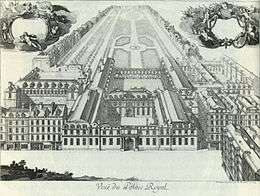
_-_Gourret_1985_p42.jpg)
First theatre
The Palais-Royal was originally known as the Palais-Cardinal, since it was built in the 1630s as the principal residence of Cardinal Richelieu.[3] In 1637 Richelieu asked his architect Jacques Le Mercier to begin work on the theatre, which opened in 1641 and was initially known as the Great Hall of the Palais-Cardinal.[1][4] Upon Richelieu's death in 1642, he left the property to King Louis XIII, and it became known as the Palais-Royal, although the name Palais-Cardinal sometimes still continued to be used.[5]
Molière
The troupe of Molière and the Comédie-Italienne put on the shows here between 1660 and 1673.[1] Molière's most notable plays were performed here, including L'École des femmes (first performed 26 December 1662), Tartuffe (12 May 1664), Dom Juan (15 February 1665), Le Misanthrope (4 June 1666), L'Avare (9 September 1668), Le Bourgeois gentilhomme (23 November 1670), and Le malade imaginaire (10 February 1673).[6]
Paris Opera
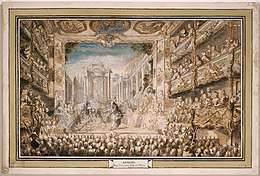
On the death of his old collaborator, Lully ejected Molière's troupe to a new home at the Hôtel de Guénégaud and re-used the theatre as the opera house of the Académie royale de Musique (the name of the Paris Opera at the time). Lully had much building work done on it in order to allow the installation of new stage machinery designed by Carlo Vigarani, capable of supporting the imposing sets of the operas he would later put on here. This replaced the old machinery designed by Giacomo Torelli in 1645.[1] After Vigarani's modifications the theatre had a total capacity of about 1,270 spectators: a parterre for 600 standing, amphitheatre seating for 120, and boxes with balconies accommodating another 550. The stage was 9.4 meters across and 17 meters deep, with space in front for the orchestra 7.6 meters across and 3 meters deep.[7]
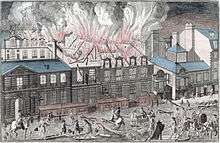
Several of Lully's operas (tragédies en musique) were premiered at the Palais-Royal, including Alceste (19 January 1674), Amadis (18 January 1684), and Armide (15 February 1686). In the 18th century many of Rameau's works were first performed here, including Hippolyte et Aricie (1 October 1733), Les Indes galantes (23 August 1735), Castor et Pollux (24 October 1737), Dardanus (19 November 1739), and Zoroastre (5 December 1749).[8]
The Opera's first theatre was destroyed by fire on 6 April 1763.
Second theatre
.jpg)
The City of Paris, which was responsible for the opera house, decided to build a new theatre on a site slightly further to the east (where the rue de Valois is located today).[9] In the meantime the company performed in the Salle des Machines in the Tuileries Palace, which was first reduced to a size more suitable for opera by the architect Jacques-Germain Soufflot.[10] The new theatre in the Palais-Royal was designed by architect Pierre-Louis Moreau Desproux and was the first purpose-built opera house in Paris.[11] It had a capacity of more than 2,000 spectators.[12]
The new theatre opened on 20 January 1770 with a performance of Rameau's Zoroastre.[13] It is especially noteworthy as the theatre where most of the French operas of Christoph Willibald Gluck were first performed, including Iphigénie en Aulide (19 April 1774), Orphée et Eurydice (the French version of Orfeo ed Euridice) (2 August 1774), the revised version of Alceste (23 April 1776), Armide (23 September 1777), Iphigénie en Tauride (18 May 1779), and Echo et Narcisse (24 September 1779). Among the many other works premiered here are Piccinni's Atys (22 February 1780), Grétry's Andromaque (6 June 1780), Philidor's Persée (27 October 1780), and Piccinni's Iphigénie en Tauride (23 January 1781).[14]
The theatre continued to be used by the Opera until 8 June 1781, when it too was destroyed by fire. The Théâtre de la Porte Saint-Martin, much further to the north on the Boulevard Saint-Martin, was hurriedly built in two months to replace it. In the meantime the opera company performed in the Salle des Menus-Plaisirs on the rue Bergère.[2]
(48.862814°N 2.337561°E)
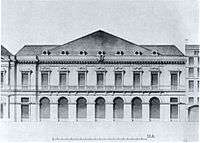 Facade of Moreau's opera house
Facade of Moreau's opera house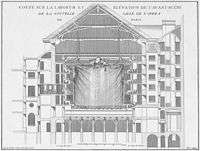 Transverse section
Transverse section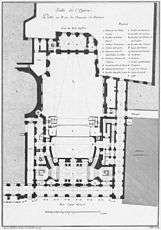 Ground-level floorplan
Ground-level floorplan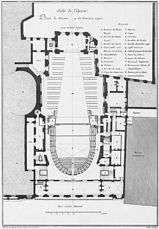 First-loges level
First-loges level
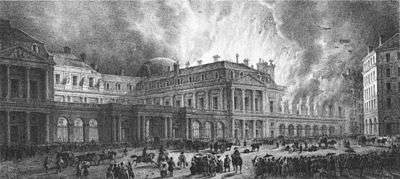
.jpg)
References
- Notes
- Coeyman 1998, pp. 60–71.
- Pitou 1983, pp. 26–30.
- Ayers 2004, p. 47.
- Clarke 1998, pp. 1–2, 19–20.
- Ayers 2004, p. 47; Bjurstrom 1961, p. 123.
- Garreau 1984, pp. 417–418.
- Harris-Warrick, Rebecca (1992). "Paris. 2. 1669–1725" in Sadie (1992) vol. 3, pp. 856–857.
- Simeone 2000, p. 181.
- Pitou 1983, p. 26; Ayers 2004, pp. 47–48.
- Harris-Warrick, Rebecca. "Paris. 3. 1725–1789" in Sadie 1992, vol. 3, pp. 860–864.
- Mead 1991, p. 45.
- Pitou 1983, p. 26, gives a capacity of 2,500. Simeone 2000, p. 181, says it held 2,000.
- Pitou 1983, p. 26, and Mead 1991, p. 45, both say it opened on 20 January 1770. Simeone 2000, p. 181, says it opened on 26 January 1770.
- Pitou 1985, pp. 566–567.
- Sources
- Ayers, Andrew (2004). The Architecture of Paris. Stuttgart: Axel Menges. ISBN 9783930698967.
- Bjurström, Per (1962). Giacomo Torelli and Baroque Stage Design, 2nd revised edition, translated from the Swedish. Stockholm: Almqvist & Wiksell. OCLC 10226792.
- Clarke, Jan (1998). The Guénégaud Theatre in Paris (1673–1680). Volume One: Founding, Design and Production. Lewiston, New York: The Edwin Mellen Press. ISBN 9780773483927.
- Coeyman, Barbara (1998). "Opera and Ballet in Seventeenth-Century French Theatres: Case Studies of the Salle des Machines and the Palais Royal Theater" in Radice 1998, pp. 37–71.
- Garreau, Joseph E. (1984). "Molière", pp. 397–418 in McGraw-Hill Encyclopedia of World Drama, Stanley Hochman, editor in chief. New York: McGraw-Hill. ISBN 9780070791695.
- Mead, Christopher Curtis (1991). Charles Garnier's Paris Opera. Cambridge, Massachusetts: The MIT Press. ISBN 978-0-262-13275-6.
- Pitou, Spire (1983). The Paris Opéra: An Encyclopedia of Operas, Ballets, Composers, and Performers. Genesis and Glory, 1671–1715. Westport, Connecticut: Greenwood Press. ISBN 9780313214202.
- Pitou, Spire (1985). The Paris Opera: An Encyclopedia of Operas, Ballets, Composers, and Performers. Rococo and Romantic, 1715-1815. Westport, Connecticut: Greenwood Press. ISBN 9780313243943.
- Radice, Mark A., editor (1998). Opera in Context: Essays on Historical Staging from the Late Renaissance to the Time of Puccini. Portland, Oregon: Amadeus Press. ISBN 9781574670325.
- Sadie, Stanley, editor (1992). The New Grove Dictionary of Opera (4 volumes). London: Macmillan. ISBN 978-1-56159-228-9.
- Simeone, Nigel (2000). Paris: a musical gazetteer. Yale University Press. ISBN 978-0-300-08053-7.
External links


